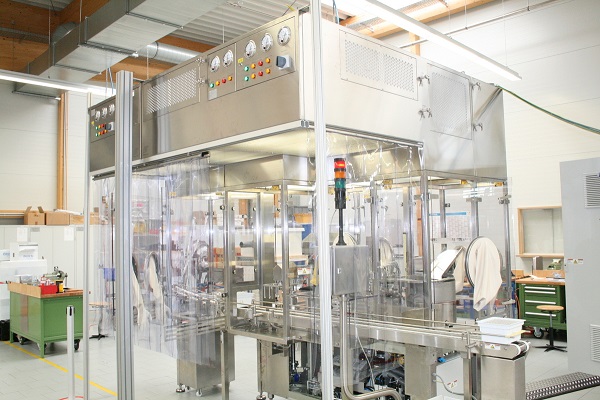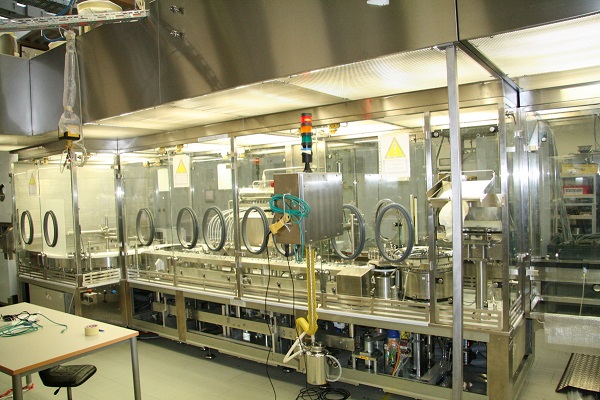"What, You Call That A RABS?" 7 (Real-Life) Aseptic Filling Blunders To Avoid
By Herman F. Bozenhardt and Erich H. Bozenhardt
 Restricted-access barrier systems (RABS) have been a major part of pharmaceutical aseptic filling operations for many years. They were introduced around the year 2000, and by 2007 there were 75 installations in the business globally.1 Today, there may be several hundreds, most of which are in GMP-compliant facilities and serving the needs of the business. RABS were born out of the need to: 1) protect the operators from the products they were filling, 2) improve filling compliance, 3) provide better access to a wider variety of filling process equipment, and 4) bring legacy lines into better compliance. This last point is critical for CMOs because their batch sizes vary widely, necessitating frequent and rapid changeovers, as well as addressing the variations in vial sizes and filling setup parameters.
Restricted-access barrier systems (RABS) have been a major part of pharmaceutical aseptic filling operations for many years. They were introduced around the year 2000, and by 2007 there were 75 installations in the business globally.1 Today, there may be several hundreds, most of which are in GMP-compliant facilities and serving the needs of the business. RABS were born out of the need to: 1) protect the operators from the products they were filling, 2) improve filling compliance, 3) provide better access to a wider variety of filling process equipment, and 4) bring legacy lines into better compliance. This last point is critical for CMOs because their batch sizes vary widely, necessitating frequent and rapid changeovers, as well as addressing the variations in vial sizes and filling setup parameters.
There are many excellent and scholarly articles written about RABS and RABS vs. isolators; however, this is not a technical article. This article is based upon our travels over the last 10 years, looking at aseptic filling operations and seeing what was described to be “a RABS” by the various owners. These RABS are all dubious devices created by their owners, who are deluding themselves into believing they have a validated aseptic RABS. Some of these are actually amusing, and they illustrate what happens when “hands-on” engineering meets the needs of operations while the compliance department is asleep at the wheel.
Basics Of RABS And Aseptic Filling
Although most of our readers are keenly aware of the types of RABS out there, let us review the standard types of the enclosure systems that encapsulate the open vials from the tunnel exit through the capping process.
- Active RABS – This design has its own HVAC/AHU and maintains the EU class A environment and recommended downward velocity of .36 to .45 m/s independent of the room’s HVAC system (as well as temperature and relative humidity).
- Passive RABS – Similar to the active RABS, this unit’s enclosure sides extend up to the ceiling and interface with the terminal HEPA array to provide the airflow. This design is dependent on the suite’s HVAC.
- Open RABS - This unit typically is a retrofit of an existing non-barrier line in which the airflow exits the unit below the fill line and exhausts into the room. This cannot be used while filling any cyto/toxin/potent compound.
- Closed RABS - This unit encapsulates the air internally, HEPA filters it, and recirculates it back to the unit or an HVAC return. This recirculation of the RABS air provides containment for any potent compound being filled.
The modern designs combine the characteristics of active RABS with those of closed RABS into a cohesive design. Any contemporary passive and open RABS are retrofits and need to be carefully designed. Below are examples of bad and good RABS designs.

Bad RABS design: This design is open (exhausts to the room randomly) and active (has its own HVAC/AHU overhead) but has plastic curtains that do not restrict access and generate particles.

Good RABS design: This RABS is also open and active RABS, but it has well-placed glove ports and exhaust registers to control air flow.
Case Studies
Case Study 1: Whoops, I Forgot The Glove Ports! (2015)
This RABS was developed to enclose a small batch size commercial filling system with a 10 to 30 vials per minute filler. The unit was mounted to a cut-out stainless-steel table (open RABS), with the top of the enclosure almost 2 feet below the terminal HEPA filters in the ceiling (very passive RABS), and it had no glove ports. That is correct: no glove ports. The theory was that the setup was simple and the filler would just run. However, there was no provision/access for an intermediate bulk container (IBC), or container to fill the stopper bowl or the capper bowl.
The question then arises as to how do you fill either of the bowls? Actually, very simply, by having the doors to the RABS open so the operator can shake the envelope or container into the bowls, generally every 20 to 30 minutes during the fill. This constituted a continuous intervention. The environment around the RABS is 100 percent terminal HEPAs on the ceiling, with two to four operators in the room around the RABS. The operators were told that is fine, because they were in an EU class A room. This was consistent with the company’s philosophy, since when they were in the mode to feed the lyophilization machine, they filled the trays with partially stoppered filled vials and walked them across the room and hand-loaded the machine. Once the cycle was completed, the operator loaded the vials on a tray by hand, walked it over, and loaded it on a turntable connected to the capper.
This system from the start was plagued with particle excursions, to an extent that the line was “demoted” to execute only lab batches and non-human trials. The number of EU and FDA violations was extensive, as well as the falsehoods told to the operators. The last question was, how was this validated? There was no evidence that smoke studies or operational-level environmental qualification were done.
Case Study 2: Let’s Save Some Money And Use The Wall! (2013)
This also was a small-scale filling operation that used an industry standard filler for both liquid and pre-lyophilization fill and post-lyophilization capping. This RABS was an open and passive system installed in an old area with nearly 100 percent HEPA ceiling coverage. In this case, the owners used a local machine shop, and the filling system was enclosed by three clear polymer panels. Yes, only three panels, because due to space considerations, the short/width sides of the “RABS” were screwed into an epoxy painted cinder block wall, and the seam between the acrylic panel and the wall was sealed with a nice residential caulking. There were two doors built into the panels and glove ports built in only on one side (obviously), as this also was a cost-saving measure.
The terminal HEPA on the ceiling at the edge of the wall was not complete and, so as not to expose that flaw, the smoke studies were not done. In this room, the transfer of partially stoppered vials from the filler to and from the lyo was done manually in trays by the operators in the EU “Grade A space.”
This unit was inspected by regulators, earning a negative outcome that resulted in the decommissioning of the facility.
Case Study 3: Acrylic Panels Are Cheap, But Glove Ports Cost Money! (2011)
A CMO converted an existing line to accommodate a new product offering for its clients by encapsulating an existing line with a series of polymer panels, complete with doors covering the entire perimeter. The sides of the RABS were built correctly for a passive RABS, as they extended to the HEPA ceiling and were fastened to it. The return ducts were located below the filling deck; however, they fed back into the general room return plenum, which disqualified it as a closed RABS. The smoke studies were correctly done, the door placement was complete; however, even though this was an existing line, little effort was paid to how the filling mechanical setup was done, where the adjustments were, where the vials typically fall over or jam and where glove ports were needed. When in operation, there are insufficient glove ports to access the sterilizing tunnel exit, feed turntable, and worm/indexing to the filling nozzles from either side of the system, and during small batch sizes or with the use of vial sizes like the 10R, the access doors are constantly open to correct problems, pick up downed vials, and maintain the flow of the fill. Interventions were so numerous that documentation could not keep up.
The key questions in developing this design should have been: 1) how should we repurpose an old, out-of-date line? and 2) how can we focus on a mock-up of the RABS around the existing line and work with the operators before the construction is undertaken? In addition, the operators should have been trained on dealing with interventions and how to minimize the “open doors” situation, if possible.
Case Study 4: Let’s Put A RABS In The Middle Of The Busiest Part Of The Plant! (2016)
This CMO inherited an excellent filling system enclosed by clear polymer panels/door system in a passive/open RABS. The suite in which the filler/RABS exists is a large room with multiple autoclaves, lyos, auxiliary fillers, parts, equipment, etc. Beyond the need for some control and organization, the top of the RABS is 3 feet from the terminal HEPA ceiling above it. This leaves the airflow patterns in the room very dynamic, and those dynamics deflected the downward velocity and direction of the air in the filling zone. Unfortunately, this dynamic and unreliable issue was documented during the smoke studies and “validation” activities.
Passive RABS are never a good choice if you can’t connect up to the ceiling HEPAs for a reliable and steady air curtain. Secondly, if you have executed a mistake, recognize it and correct it, rather than documenting your lack of compliance and leaving it at that.
Case Study 5: Curtains Are Barriers Too? (2010)
A major filler of aseptic solutions showcased its modern filling system and called it a RABS. The standard high-speed filling hardware was surrounded by its “RABS,” which, like in the other examples, was an open and passive RABS. The RABS was connected to the ceiling-mounted terminal HEPAs for a steady airflow, and the termination of the RABS was approximately 2 feet from the floor, allowing for a steady airflow. However, rather than building in a number of those pesky glove ports and doors, one entire long side of the operational RABS was a plastic strip curtain (12-inch sections). This allowed unfettered access to the line operation, which the operators took full advantage of by being “inside” the RABS, watching, working, and adjusting the fill.
In this case, the words “restricted” and “access” did not fully translate into the company’s understanding of RABS. The constant movement of the plastic curtains (covered with residual disinfectant) and the presence of the operators under the plastic created a nightmare scenario of deviations on particle counts, which were often blamed on the HEPAs.
Case Study 6: Curtains Are Barriers Too? … Again (2017)
A manufacturer of small lots of aseptic solutions was inspected by the FDA. It showed the agency its aseptic filling operation, which consisted of an “ISO 5” area that was a section of room with full HEPA coverage and plastic strip curtain separation from the surrounding ISO 8 space. Since the fills were small lots in widely varying container types and sizes, the filling operation was manual and conducted on solid stainless-steel tables with dosing pumps. Furthermore, the layout of the “ISO 5” space contained multiple tables, with the operators inside the plastic curtains.
The company’s defense was that the validation data was good. It met ISO 5 when no one was in the area. The FDA reminded them that ISO 5 applies during operations and is usually validated as such during a mock run or media fill.
Case Study 7: The Peek A Boo RABS (2008)
Our last case study is yet another high-speed filling line with a properly designed open and passive RABS. The RABS extended up to the terminal HEPA ceiling and was enclosed on all four sides. Glove ports and doors all seemed to be in order, except for the area directly in front of the filling nozzles. That was an entirely open section of 3 feet long by 2 feet high, so the operator had direct hand/tweezer/forceps access to the vials at the time of the fill.
Why was this done? The short answer is the filling system was yet another retrofit that was problematic at best. By making the filling section “readily accessible,” the company was able to reduce downtime, minimize glass breakage, and reduce the staffing of the fill line by eliminating the need for a full-time mechanic at the ready.
Lessons Learned
- In almost all these cases the filling lines were retrofitted, with very little consideration to changing or upgrading the filling machines. This left very problematic fillers with less access and more potential problems.
- All of these RABS were built internally or by local machine shops with little to no experience in the requirements and dynamics of the RABS operation.
- Operations management was the driving focus of the design and, in some cases, little input from the operators was obtained. In other cases, they over-accommodated the operators to the level of noncompliance.
- Engineering companies, RABS design and building firms, and experts were not consulted or engaged.
- All these were open RABS to accommodate an existing line and, except for one case, were not based on any dynamic airflow studies.
- Cost was a factor.
- The QA organization was not aware or not involved.
- EU Grade A does not permit human operators within the enclosure, and handling of vials partially stoppered is not compliant.
Conclusions
- An active closed RABS is always recommended. If needed, a passive RABS can only work if it is extended to and attached to the terminal HEPA ceiling; no other practical approach is recommended.
- Any RABS must be custom built by a recognized RABS builder with many years of experience and references. This must be done in conjunction with the filler manufacturer.
- A trip to a hardware store or your local machine shop is never a good idea.
- An active RABS is the best approach overall in order to control the airflow pattern, assuring the recommended downward velocity and particle count. This is also key to being independent of the room’s HVAC system.
- A properly compliant RABS costs money.
- A closed RABS is preferable in order to control the room’s airflow dynamics and to protect the operator from the product and reduce operating costs.
- In the design of any RABS, the filling system ergonomics are key. Involving the operators and using mockups to assess where to position the doors and glove ports can make the difference between success and failure of the line.
- QA must be very active and, if they are unfamiliar with RABS, they must educate themselves quickly and thoroughly.
- Sometimes you have to just look at what you are designing and building and ask yourself if it makes sense!
- When in doubt, read EU GMP Annex 1.
References:
- Advantages of Restricted-Access Barrier Systems, March 2, 2007, Johannes Rauschnable, Pharmaceutical Technology.
About The Authors:
 Herman Bozenhardt has 42 years of experience in pharmaceutical, biotechnology, and medical device manufacturing, engineering, and compliance. He is a recognized expert in aseptic filling facilities and systems and has extensive experience in the manufacture of therapeutic biologicals and vaccines. His current consulting work focuses on the areas of aseptic systems, biological manufacturing, and automation/computer systems. He has a B.S. in chemical engineering and an M.S. in system engineering, both from the Polytechnic Institute of Brooklyn. You can reach him at hermanbozenhardt@gmail.com or connect with him on LinkedIn.
Herman Bozenhardt has 42 years of experience in pharmaceutical, biotechnology, and medical device manufacturing, engineering, and compliance. He is a recognized expert in aseptic filling facilities and systems and has extensive experience in the manufacture of therapeutic biologicals and vaccines. His current consulting work focuses on the areas of aseptic systems, biological manufacturing, and automation/computer systems. He has a B.S. in chemical engineering and an M.S. in system engineering, both from the Polytechnic Institute of Brooklyn. You can reach him at hermanbozenhardt@gmail.com or connect with him on LinkedIn.
 Erich Bozenhardt is the process manager for Integrated Project Services’ process group in Raleigh, NC. He has 12 years of experience in the biotechnology and aseptic processing business and has led several biological manufacturing projects, including cell therapies, mammalian cell culture, and novel delivery systems. He has a B.S. in chemical engineering and an MBA, both from the University of Delaware. You can reach him at ebozenhardt@ipsdb.com or connect with him on LinkedIn.
Erich Bozenhardt is the process manager for Integrated Project Services’ process group in Raleigh, NC. He has 12 years of experience in the biotechnology and aseptic processing business and has led several biological manufacturing projects, including cell therapies, mammalian cell culture, and novel delivery systems. He has a B.S. in chemical engineering and an MBA, both from the University of Delaware. You can reach him at ebozenhardt@ipsdb.com or connect with him on LinkedIn.
